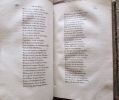1260 books for « hamilton e »Edit
-
Type
Book (1244)
Magazine (1)
Music sheets (9)
New book (1)
Photographs (3)
Posters (2)
-
Latest
Last month (52)
Last week (4)
-
Language
English (8)
French (1252)
-
Century
18th (32)
19th (129)
20th (495)
21st (152)
-
Countries
Belgium (66)
Brazil (1)
Canada (9)
China (2)
Côte d'Ivoire (1)
Denmark (8)
France (1075)
Germany (1)
Italy (5)
Netherlands (3)
Switzerland (88)
United Kingdom (1)
-
Syndicate
ALAC (8)
CLAM (2)
CLAQ (1)
ILAB (605)
NVVA (9)
SLACES (9)
SLAM (560)
SNCAO (1)
Topics
- Africa (5)
- Anticipation (9)
- Architecture (5)
- Autographs (5)
- Bachaumont (5)
- Bibliophilism (3)
- Biography (15)
- Carpenter (4)
- Children’s books (9)
- Cinema (4)
- Civilisation (4)
- Curiosa (17)
- Dance & ballet (4)
- Dancing (3)
- Denmark (3)
- Detective novels (23)
- Dictionaries (4)
- Doisneau robert (9)
- Early printed books (7)
- England (11)
- English (92)
- English literature (6)
- Engraving (books about) (3)
- Erotic (7)
- Fantastic (8)
- Far east (3)
- Fashion (5)
- Fine arts (20)
- First edition (27)
- Flechier (4)
- Flora (3)
- French literature (4)
- Genetics (3)
- Geography (5)
- Geology (3)
- Germanic languages (4)
- Great britain (4)
- Greece (7)
- Greek (4)
- Hamilton edmond (19)
- History (62)
- Hugo victor (22)
- Industrial arts & crafts - fine arts (4)
- Ireland (5)
- Iron (23)
- Italian (3)
- Italy (3)
- Japan (5)
- Lefranc de pompignan (4)
- Linguistics (3)
- Literature (120)
- Literature xviith (3)
- Manuscripts (3)
- Memories (3)
- Memories (25)
- Military arts (4)
- Monographs (3)
- Mythology (6)
- Navy (5)
- North america (4)
- Painting (6)
- Paris (3)
- Parny (3)
- Perrault charles (5)
- Philosophy (6)
- Photography (57)
- Pig (4)
- Poetry (6)
- Policy (3)
- Psychology (3)
- Racine jean (5)
- Railway (16)
- Regnard (5)
- Reliure (6)
- Review (4)
- Ruth (3)
- Saint- pierre jacques henri bernardin de (3)
- Science fiction (18)
- Scores (10)
- Songs (9)
- Spying (8)
- Surrealism (6)
- Tales (14)
- Tea (5)
- Translation (14)
- Travel (10)
- United kingdom (10)
- United states (9)
- Various (17)
- Voltaire (5)
- War (20)
- Western (3)
- Wildlife (5)
- Women (the) (5)
- Xviii th century (5)
Filles fleurs.
Editions AGEP Marseille 1979 Petit in-folio ( 415 X 305 mm ), en feuilles sous coffret illustré de léditeur. . 4 feuillets illustrés suivi de 10 planches photographiques hors-texte de David HAMILTON portant la signature de lartiste en fac-similé. Très bel exemplaire à l'état de neuf dans son carton d'origine.
Le Galet blanc.
Editions AGEP Marseille 1980 Petit in-folio ( 415 X 305 mm ), en feuilles sous coffret illustré de léditeur. Titre illustré, édition originale de la préface de Philippe GAUTIER et 12 planches photographiques hors-texte de David HAMILTON portant la signature de lartiste en fac-similé. Très bel exemplaire à l'état de neuf dans son carton d'origine.
Contes d'HAMILTON. ( 2 volumes ).
L. De Bure, Libraire Paris 1826 2 volumes in-16 ( 125 X 80 mm ), demi veau blond, dos à nerfs ornés de caissons dorés et filets droits et perlés dorés, pièces de titre de maroquin grenat et de tomaison de maroquin olive, têtes dorées ( Reliures de l'époque ). Quelques rousseurs claires, jolis exemplaires, dans des reliures très décoratives en très bel état.
FLEURS. - Bouquet de roses dans un panier.
L'Ariana Pictures Paris 1990 In-4 carré ( 295 X 270 mm ) de 120 pages, cartonnage vert à la bradel sous jaquette illustrée en couleurs. Nombreuses photographies en couleurs hors-texte dans un registre inhabituel pour cet artiste. Edition originale, 1 des 150 exemplaires justifiés et signés par David HAMILTON accompagné d'un tirage argentique original également justifié et signé sous cadre bois et verre avec certificat au dos. Bel ensemble en parfait état.
CONTES d'HAMILTON. 4 tomes en 2 volumes.
Librairie Des Bibliophiles - Jouaust Paris 1873 4 tomes reliés en 2 volumes in-12 ( 180 X 115 mm ) de 192 126 158 et 120 pages, demi-maroquin rouge à coins, dos à nerfs jansénistes, tête dorées. Beaux exemplaires, bien reliés.Tome 1 - Le Bélier. Tome 2 - Fleur d'épine. Tome 3 - Les quatre Facardins. Tome 4 - Zénéyde suivie de L'Enchanteur Faustus.
Contes d'HAMILTON.
De Bure Paris 1926 2 volumes in-16 ( 135 X 85 mm ), demi-chagrin framboise, dos à nerfs ornés de filets à froid, têtes dorées. Gravure en frontispice. Rousseurs claires, jolis volumes agréablement reliés.
Les bêtes sauvages de l'Afrique du Sud.
Payot Paris 1952 In-8 ( 225 X 140 mm ) de 344 pages, broché sous couverture illustrée. Très bel exemplaire.
The Genetical Evolution of Social Behaviour, I (+) The Genetical Evolution of Social Behaviour, II. - [HAMILTON'S RULE]
London, Academic Press, 1964. 8vo. In the original grey printed wrappers. In ""Journal of Theoretical Biology"", Volume 7, Number 1, July 1964. Entire issue offered. A very fine and clean copy. Pp. 1-16"" Pp. 17-52. [Entire volume: 170, (2) pp.].
First printing of Hamilton's two seminal publications, perhaps the most important in evolutionary biology in the 20th century, on altruism in relation to kin selection. Hamilton is, primarily because of the present publication, widely regarded as being one of the most influential theoretical biologists of the twentieth century. ""Hamilton's principal achievement was so thoroughly to revise the language of evolutionary biology that it has become nearly impossible to speak in evolutionary explanations except in terms of the self-interest of the organism or gene."" (DSB)Hamilton's rule: k> 1/r, a gene causing an organism to benefit relatives at the expense of its own reproduction will be selected and increase in a population if the benefit to the ""altruist"" outweighs the discounted relationship, or as Hamilton himself described it: ""a gene causing altruistic behavior towards brothers and sisters will be selected only if the behavior and the circumstances are generally such that the gain is more than twice the loss" for half-brothers it must be more than four times the loss" and so on. To put the matter more vividly, an animal acting on this principle would sacrifice its life if it could thereby save more than two brothers, but not for less."" (DSB). Due to the complexity and advanced mathematics the paper was rejected twice until it was accepted by the reviewer's an it was not until the mid 1970ies that his theory became widely know and cited: ""Hamilton wrote up the theory of inclusive fitness in two versions. One was a lengthy, fully mathematical treatment that unified understanding of a considerable body of case studies of altruistic behaviors that Hamilton drew from the scientific literature, the fruit of his graduate research. The second was a short, mostly verbal abstract of the whole, containing only the mathematical relation of Hamilton's rule and some general, theoretical remarks on its applicability. He met difficulty in publishing both. The first he submitted to the Journal of Theoretical Biology, where it spent considerable time in the reviewing process"" ultimately the referee (John Maynard Smith, a mathematical biologist of similar interests) asked that it be split into two parts. After the revisions and splitting called for by the referee for the Journal of Theoretical Biology, that journal published ""The Genetical Evolution of Social Behaviour,"" parts 1 and 2, in 1964. The first part of the paper contained the mathematical arguments culminating in the derivation of Hamilton's rule"" its arguments were almost exclusively cast in the language and methodology of modern population genetics. The second part hearkened back in its methodology to Darwin's, as Hamilton used the theory of inclusive fitness to explain a diverse array of social traits recorded in the biological literature, including alarm calling, mutual grooming, the fusion of colony organisms, and postreproductive behavior in cryptic (camouflaged) moth species compared with that of aposematic species (bad-tasting with vivid warning colors). In each case, Hamilton argued that his theory of inclusive fitness could coherently explain the evolution of phenomena that had been disparate in the literature as aspects of a single principle at work, Fisher's fundamental theorem of natural selection, mandating the maximization of favorable genes under selection.Hamilton's influence began to grow among evolutionary biologists as the few who had read and understood the import of his papers worked to bring him from his initial scientific and social isolation into the networks of scientists interested in evolution and behavior. Wilson, for example, invited Hamilton to lecture at Harvard University in 1969, en route to a Smithsonian Institution conference on ""Man and Beast"" that brought together specialists from various fields to discuss the impact of recent biological work on understandings of human nature""From about 1974, citations of Hamilton's 1964 papers in the scientific literature began an exponential rise, reaching some four thousand total in the Institute for Scientific Information (ISI) Web of Science database by 2007, making ""The Genetical Evolution of Social Behaviour"" the most-cited paper ever published in the Journal of Theoretical Biology. Hamilton's principal achievement was so thoroughly to revise the language of evolutionary biology that it has become nearly impossible to speak in evolutionary explanations except in terms of the self-interest of the organism or gene."" (DSB)
Alexander Hamilton: Writings (LOA #129) (Library of America Founders Collection Band 4)
Library of America 2001 1108 pages 12 954x3 302x20 066cm. 2001. Cartonné jaquette. 1108 pages.
Comme neuf avec sa jaquette intérieur propre bonne tenue
HAMILTON, WILLIAM ROWAN. - THE GENERAL PRINCIPLE OF LEAST ACTION - HAMILTON' S PRINCIPLE.
Reference : 42329
(1834)
On a general Method in Dynamics" by which the Study of the Motions of all free Systems of attracting or repelling Points is reduced to the Search and Differentiation of one central Relation, or characteristic Function. Received April 1, - Read April 1...
London, Richard Taylor, 1834-35. 4to. No wrappers as extracted from ""Philosophical Transactions"" 1834 - Part II. and 1835 - Part I. Both titlepages to the volumes present.Pp. (2),247-308 a. (2),95-144. Both papers clean and fine.
First appearance of these two groundbreaking papers in which Hamilton carries further the dynamics of Lagrange by expressing the kinetic energy in terms of the momenta and the co-ordinates of a system, and discovers how to transform the Lagrangian equations into a set of differential equations of the first order for the determination of of the motion. The Hamilton principle is also called The Principle of ""Least Action"". The Hamilton Principle as stated in the papers offered here ""was the first of his two great ""discoveries"". he second was the quaternions, which he discovered...1843 nd towhich he devoted most of his efforts during the remaining 22 years of his life.""(DSB).Maupertouis, Euler, and Lagrange introduced the principle of ""Least Action"" covering the science of dynamics, and now Hamilton brought the principle into a form which was capable of expressing all the laws of Newtonian science in a representation as minimum-problems, that is, all gravitational, dynamical and electrical laws could be represented as minimum problems. In 1925 Heisenberg, Born and Jordan showed, that the Hamilton equations are still valid in quantum theoryAlthough formulated originally for classical mechanics, Hamilton's principle also applies to classical fields such as the electromagnetic and gravitational fields, and has even been extended to quantum mechanics, quantum field theory, relativity and criticality theories. Its influence is so profound and far reaching that many scientists regard it as the most powerful single principle in mathematocal physics and place it at the pinnacle of physical science.
On Quaternions" or on a new System of Imaginaries in Algebra. - [MAKING THE GENERAL THEORY OF RELATIVITY POSSIBLE]
London, Richard and John Taylor, 1844. Contemp. hcalf. Gilt lettering to spine ""Philosophical Magazine"" - Vol. XXV. In: ""The London, Edinburgh, and Dublin Philosophical Magazine and Journal of Science. Conducted by David Brewster et al."". Vol. XXV. A stamp to titlepage and a few other pages. Entire volume offered (July-December 1844). VIII,552 pp., textillustr. Hamilton's paper: pp. 10-13, 141-145 and 241-246.
First printing of this landmark paper in which Hamilton published his creation of a new algebra of quaternions (a noncommunicative algebra), a turning point in the development of mathematics and a discovery which made possible the creation of the general theory of relativity. His algebra was later to form the basis of quantum mechanics and for the proper understanding of the atom.""Gauss had treated imaginary numbers in combination with real ones as representing points on a plane and showed the methods by which such complex numbers could be manipulated. Hamilton tried to extend this to threee dimensions and found himself unable to work out a self-consistent method of multiplication, until it occurred to him that the cummutative law of multiplication need not necessarily hold. It is taken for granted that A times B is equal to B times A... and this is an example of what seems to be an eternal and inescapable truth. Hamilton, however, showed that he could built up a logical algebra for his quaternions only when B times A was not made to equal - A times B. This seems against common sense but, like Lobachevski, Hamilton showed that the truth is relative and depends on the axioms you choose to accept.""(Asimov).The creation of quaternions is one of the famous moments in the history of mathematics. ""The quaternions came to Hamilton in one of those flashes of understanding that occasionally occur after long deliberation on a problem. He was walking into Dublin on 16 October 1843 along the Royal Canal to preside at a meeting of the Royal Irish Academy, when the discovery came to him. As he described it, ""An electric circuit seemed to close.""18 He immediately scratched the formula for quaternion multiplication on the stone of a bridge over the canal. His reaction must have been in part a desire to commemorate a discovery of capital importance, but it was also a reflection of his working habits. Hamilton was an inveterate scribbler. His manuscripts are full of jottings made on walks and in carriages. He carried books, pencils, and paper everywhere he went. According to his son he would scribble on his fingernails and even on his hard-boiled egg at breakfast if there was no paper handy.""(DSB).Hamilton later developed his invention in his book from 1853 ""Lectures on Quaternions"" - see PMM: 334 and Grattan-Guiness ""Landmark Writings in Western Mathematics 1640-1940"", pp. 460 ff.In this volume other importent papers by Gassiot, Sylvester, Joule, Draper.
A Princeton Girl , Just from London ; Bessie "Stroke at Vassar" ; Monte-Carlo Girl ; A Quiet Game ; Florodora.
1902 6 lithographies couleurs 18 x 14 cm, 1902, menus manuscrits au verso de 5 des 6 lithographies.
Hamilton King (1871-1952) fut le créateur d'un style d'illustration de belles jeunes femmes strictement contemporain des "Gibson Girls". La popularité de l'artiste, de ses cartes postales et couvertures de revue en la période fin de siècle américaine, fut telle qu'on parlait bientôt de "Hamilton King Girls". Ces "girls" avaient souvent pour modèles les jeunes femmes d'une génération pionnière, celles qui intégraient les universités américaines à la fin du XIXe siècle, ou qui voyageaient déjà dans le monde comme les héroines des romans d'Henry James. C'est ainsi que parmi nos images nous trouvons "A Princeton Girl", "A Monte-Carlo Girl", et une "Girl Just From London". Depuis 1965, The Society of Illustrators aux U.S.A. décerne chaque année un prix Hamilton King aux meilleures illustrations de l'année. Les cartes Hamilton King de grand format presque carré comme les nôtres sont peu courantes. Au verso de 5 de ces belles lithographies, a été griffonné, en allemand, des menus datés des années trente. La date d'émission de ces cartes est datée de 1902. Petites usures marginales, deux petites inscriptions à l'encre, bel état d'ensemble de ces cartes qui témoignent avec un charme certain d'un moment de transition de la société américaine.
HAMILTON (Antoine) ou Anthony Hamilton, né en 1646 à Roscrea en Irlande, mort en 1720 à Saint-Germain-en-Laye
Reference : 29817
(1805)
Oeuvres complètes d'Hamilton. Nouvelle édition, revue, corrigée, précédée d'une notice historique et littéraire, disposée dans un meilleur ordre, et augmentée de plusieurs pièces en prose et en vers; avec trois portraits.
A Paris, chez Colnet, Mongie, Debray et Delaunai, an XIII-1805., 1805. 3 volumes. in-8 reliés demi-veau fauve de l'époque (20,4 x 12,5 cm), dos lisses ornés de fleurons et petits ornements dorés, pièce de titre marron, pièce de tomaison verte, filets dorés en pied, tranches mouchetées, 415-468 et 492 pages. Portrait du comte Antoine Hamilton en frontispice, portrait du comte de Grammont et portrait de Mademoiselle Hamilton, comtesse de Grammont. T. I : Mémoires de Grammont ; T. II : Fleur d'épine, conte, Le bélier, conte, Les quatre Facardins, conte, L'enchanteur Faustus, conte. T. III : Zeneyde, conte, La volupté, dialogue, Relations véritables de différens endroits d'Europe, Relation d'un voyage en Mauritanie, Lettres et Epitres, Poésies diverses, Chansons. Avec une notice historique et littéraire par L.-S. Auger.- 1570g.- Bel ensemble aux reliures agréables, en très bon état. Edition complète en trois volumes, peu courante.
SILVER BINDING - Richard BAXTER ( author ) - Harriet HAMILTON ( provenance ) :
Reference : 38172
The Saints' Everlasting Rest . or, a Treatise of the Blessed state of the Saints... ( silver binding ) .
" London, George Virtue, 1846, in-8°, 21,5 x 13,5 cm, (12)nn pp (title, engraved portait, manuscript ex-libris leaves) + 672 pp. Binding ; Silver binding over black velvet with large silver supra libro with the initials HH (130 x 80 mm), silver decoration and silver title label on spine. Both covers completely bordered with an elaborate silver frame with two large clasps. All edges gilt and decorated with a blindtooled pattern. The binding is in very good shape. Only a tiny fragment of one of the spine ornaments is missing. Provenance; Bound before the title are two vellum paper leaves containing quotes from the bible and the opening sentence ; '' Harriet Hamilton, her book, june 1854''. Also the initials HH on the front cover refer to Harriet Hamilton. Most probably (*) this book belonged to Lady Harriet Hamilton (*6.7.1834 , +23.4.1913) daughter of James Hamilton 1st Duke of Abercom. She is depicted as a baby in a famous painting by Landeer. There exists a picture by Roger Fenton of her which would have been taken during the time when she purchased this book ; 12 May 1854 ; Lady Harriet Hamilton as Mary Queen of Scots, for Countess Walewska's Ball. In this picture she is portrayed with one book on her lap and two books on a nearby table (Royal Collection RCIN 2906578). Fenton depicted her also as Lady Jane Grey in the same year, in a similar pose, also surrounded by books (San Francisco AMICA library ID FASF.6065). (*)We can not ascribe this book with absolute certainty to the library of Lady Harriet Hamilton because several persons with her name lived in England around 1854. However the luxurious execution of the binding which would have been very expensive, together with the fact that she was in her prime in 1854 and socially very active makes her the most likely candidate."
Histoire de Fleur d’Epine, conte. « Histoire de Fleur d'Epine », la féérie d'Hamilton
« Édition originale de cette délicieuse féérie, un des chefs-d’œuvre du genre » (Tchemerzine). Paris, Jean Fr. Josse, 1730. In-12 de (2) ff., 275 pp., (1). Relié en plein maroquin rouge de l’époque, triple filet doré encadrant les plats, dos à nerfs orné de filets dorés dans les caissons, coupes décorées, roulette intérieure dorée, tranches dorées sur marbrures. Reliure de l’époque. 161 x 95 mm.
« Édition originale de cette délicieuse féérie, un des chefs-d’œuvre du genre, et l’une des meilleures productions de ce célèbre auteur. » (Gumuchian, Les livres de l’enfance, 2930). Tchemerzine, III, 658 ; Picot, Catalogue Rothschild, n°1737). « Un ex. en basane ancienne a été vendu 800 francs en 1931, il avait été vendu 80 francs neuf années plus tôt. Ce conte fut écrit par Hamilton pour montrer aux dames de la Cour, alors entichées des ‘Mille et Une Nuits’, que l’on pouvait composer des histoires aussi invraisemblables. Ceci explique l’extravagance que l’on y rencontre. » (Tchemerzine). « Le f. qui suit le titre contient un avis où il est dit que l’accueil fait par le public au ‘Conte du Bélier’ a déterminé le libraire à rechercher avec soin les ouvrages composés par Hamilton pour l’amusement de sa sœur, la duchesse de Gramont. On y voit que ‘l’Histoire de Fleur d’Epine’ et ‘Les quatre Facardins’ parurent ensemble. » (Picot). « Édition originale de cette délicieuse féérie » (Catalogue de Backer, n°1068). « Ecrivain français né en Irlande vers 1646, Hamilton passa en France avec sa famille après la mort de Charles Ier pour se soustraire aux vengeances révolutionnaires exercées contre les royalistes fidèles. Ce fut là qu’il fit ses études ; mais en 1660, à l’âge de 14 ans, il repassa en Angleterre, lors du rétablissement du prince de Galles, sous le nom de Charles II, sur le trône des Stuarts, et il put y achever son éducation française, dans une cour qui parlait fort bien notre langue […] C’est avec justice que Voltaire l’a placé dans son ‘Temple du Goût’ […] Quel que fût son caractère, son esprit était aisé, son imagination brillante et facile, son goût délicat et fin. Par une singularité piquante, c’est Hamilton, un étranger, qui, après Voltaire, présente peut-être l’image la plus exacte de l’esprit français […] ‘Fleur d’Epine’ est délicieux de tous points, si l’on veut bien se reporter au but de l’auteur, et se laisser aller, sans les juger avec une raison trop sévère, à toutes ces fééries qu’il accumula avec tant d’esprit et d’imagination. Dans un tout autre genre, la narration n’y est guère inférieure à celle des ‘Mémoires’ ; on y trouve l’intérêt, le goût, le naturel, et même une vérité relative qui n’est nullement incompatible avec les contes de fées : il est rempli, suivant une expression reçue, de charmants tableaux de genre, dont la grâce égale la variété. » (Nouvelle Biographie générale, t. 23, c. 233-236). Précieux exemplaire de cette originale littéraire revêtu d’un élégant maroquin rouge de l’époque.
Contes d'Hamilton, par ordre de Mgr le Comte d'Artois (3 volumes)
A Paris, de l'Imprimerie de Didot l'Aîné, 1781, 3 volumes in-16 de 125x75 mm environ, viij-211, 164, et 207 pages, pleine basane vert olive, dos lisses portant titres et tomaisons dorés sur pièces bordeaux, ornés de caissons à petits fers et motifs dorés, chasses et coupes dorées, plats encadrés d'un triple filet doré avec petit à chaque angle, tranches dorées. Quelques rousseurs en début et fin de volume, mouillure sur la couverture et les gardes de couleurs du tome I, 3 infimes petits trous de ver sur un mors du tome 3, sinon bon état.
Antoine Hamilton ou Anthony Hamilton, né en 1646 à Roscrea en Irlande, mort le 21 avril 1720 à Saint-Germain-en-Laye en France, est un écrivain écossais d'expression française.Les contes d'Hamilton furent rédigés entre 1695 et 1715 : ils n'étaient pas destinés à être publiés mais circulèrent en manuscrits à la Cour et dans les milieux lettrés. Merci de nous contacter à l'avance si vous souhaitez consulter une référence au sein de notre librairie.
MÉMOIRES DE LA VIE DU COMTE DE GRAMMONT
MÉMOIRES DE LA VIE DU COMTE DE GRAMMONT ; contenant particulièrement l'histoire amoureuse de la cour d'Angleterre, sous le règne de Charles II. A Cologne [i.e. Rotterdam], chez Pierre Marteau [i.e. Michel Boehm et Caspar Fritsch], 1713 1 volume in-12 (16,6 x 9,5 cm) de IV-426-(2) pages. Reliure plein maroquin rouge de la deuxième moitié du XIXe siècle (vers 1880) signée Chambolle-Duru. Triple-filet doré en encadrement des plats, double-filet doré sur les coupes, dos à nerfs richement orné aux petites fers, jeu de roulettes et filets dorés en encadrement intérieur des plats, doublures et gardes de papier peigne, tranches dorées. Exemplaire soigneusement lavé et réencollé au moment de la reliure. Exemplaire très frais à l'état proche du neuf. ÉDITION ORIGINALE.
Une particularité curieuse distingue l'édition originale de Cologne, 1713. L'éditeur a pris soin d'indiquer en italique tous les mots sur lesquels il pensait que devait s'arrêter l'attention dos lecteurs. On aurait peine à croire, sans en juger par soi-même, à quelle quantité de mots s'est appliqué ce procédé." [et tous les noms des personnes sont en majuscules]. (Gay) Jules Le Petit et Tchémerzine dénombrent 3 tirages sous la même adresse et à la date de 1713. La priorité de l'un sur l'autre n'est absolument pas démontrée, les différences étant très minimes (2 ont une justification quasi identique avec quelques changements dans la typographie et les ornements utilisés). Antoine Hamilton ou Anthony Hamilton, né en 1646, mort le 21 avril 1719 à St Germain-en-Laye, est un écrivain écossais d'expression française. Descendant d'une famille de vieille noblesse catholique écossaise, sa date de naissance n'est pas absolument sûre (1645 ou 1646). Il est le troisième d'une famille de six garçons et trois filles ; en 1651, les Hamilton s'exilent en France pour échapper à la dictature de Cromwell après l'exécution de Charles Ier ; Anthony y fait ses études, s'imprégnant de la culture et de la littérature françaises de l'époque Louis XIII, et rejoint l'Angleterre en 1661 sous le règne de Charles II, où il fréquente la meilleure société ; en 1663, il rencontre le comte de Grammont, esprit brillant et libertin qui épouse sa sœur Elizabeth en 1663 et l'emmène en France. En 1668, il entame une carrière militaire dans le cadre d'une « gendarmerie » anglaise de l'armée royale française ; il rejoint son pays en 1678. À l'avènement de Jacques II (1685), Hamilton s'engage dans la vie politique irlandaise : il est nommé gouverneur de Limerick et semble avoir reçu du roi un régiment d'infanterie. Lorsque Guillaume d'Orange monte sur le trône, il combat pour la restauration à partir de l'Irlande, tandis que Jacques II est accueilli en France au château de Saint-Germain, sous la protection de Louis XIV. Anthony Hamilton rejoint cette cour exilée vers 1695. Il logera dans la ville de Versailles jusqu'à sa mort, en 1719. Il y mène une vie mondaine, fréquente le maréchal de Berwick, fils naturel de Jacques II, et se distrait de l'atmosphère pesamment dévote de la cour auprès des quatre sœurs Bulkeley (le conte du Bélier est dédié à Henriette) ; il écrit des vers de circonstance et des chansons galantes qui le font admettre comme un bon poète dans les petites cours littéraires de l'époque, notamment la cour de Sceaux ; il fréquente chez sa sœur à Versailles, laquelle est appréciée du roi au point d'en avoir reçu une maison dans le parc du château ; il écrit les Mémoires du comte de Gramont inspirés de la vie de son beau-frère (publication en 1713), et invente des contes orientaux parodiques qui circulent en manuscrit mais ne seront publiés qu'en 1730. On prétend qu'Hamilton, si gai dans ses écrits, ne l'était pas du tout en société, et ne s'y faisait remarquer que par son humeur chagrine et caustique. Qui le croirait en lisant les Mémoires de Grammont ? Il est probable que le fond de l'ouvrage lui a été fourni par celui qui en est le héros, mais qu'il y a ajouté beaucoup d'ornements de son invention. Chamfort raconte que ce fut le comte de Gramont lui-même qui vendait quinze cents francs le manuscrit de ces mémoires, où il est si clairement traité de fripon. Fontenelle, censeur de l'ouvrage, refusait de l'approuver par égard pour le comte de Gramont. Celui-ci s'en plaignit au chancelier, à qui Fontenelle dit les raisons de son refus. Le comte, ne voulant pas perdre les quinze cents francs, força Fontenelle à approuver le livre d'Hamillon. « De tous les livres frivoles, dit La Harpe, c'est le plus agréable et le plus ingénieux ; c'est l'ouvrage d'un esprit léger et fin, accoutumé dans la corruption des cours à ne connaître d'autre vice que le ridicule, à couvrir les plus mauvaises mœurs d'un vernis d'élégance, à rapporter tout au plaisir et à la gaieté. II y a quelque chose du ton de Voiture, mais infiniment perfectionné. L'art de raconter les petites choses, de manière à les faire valoir beaucoup, y est dans sa perfection. » Voltaire porte à peu près le même jugement. On dit que ce fut le comte de Grammont lui-même qui vendit le manuscrit de ces Mémoires 1500 fr., et qui força Fontenelle, alors censeur, à donner son approbation à l'ouvrage. (Cf. notice du Bulletin Morgand et Fatout, n°4.864). Quelques catalogues donnent Michel Boehm et Caspar Fritsch de Rotterdam comme éditeurs de l'ouvrage. Provenance : aucune (aucun ex libris - aucune marque d'appartenance). SUPERBE EXEMPLAIRE DE L’ÉDITION ORIGINALE DE CET OUVRAGE CLASSIQUE, PARFAITEMENT ÉTABLI PAR CHAMBOLLE-DURU.
Phone number : 06 79 90 96 36
Memoires de la vie du comte de Grammont; contenant particulierement l'histoire amoureuse de la cour d'Angleterre, sous le regne de Charles II.seconde edition,
Cologne: Pierre Marteau, 1714. Hardcover Pages iv, 496, [2] pp.12mo.(17 cm). Brunet,3, p.29; Picot, 1693. reliure epoque tres abimee,manques au dos,coins frottes,texte correct;dans l’etat,photo sur demande,Picture and description upon request.
Thought to be written all or in part by Anthony Hamilton, Grammont s brother-in-law, a Jacobite officer who fought at the Boyne and settled in France after the first exile of the Stuarts. Grammont was an unscrupulous libertine and gambler who was eventually banished from the Court of Louis XIV for casting an eye (most certainly more) on one of the King"s favorites. Grammont apears to have dictated the first and most entertaining.section, down to his exile, to Hamilton while the last part, largely concerned with scandals of the court of Charles II, is by Hamilton. The memoirs are written in admirable French, in a light, easy, slightly ironic style, Remise de 20% pour toutes commandes supérieures à 200 €
Le Grand Déchiffreur (signé) Richard Hamilton sur Marcel Duchamp Une sélection d'écrits, d'entretiens et de lettres
Paris, jrp/ringier et la Maison Rouge fondation Antoine de Galbert, 2009, 225x145mm, 272p., 79 illustrations, broché sous couverture verte titrée
Avec la collaboration de Corinne Diserens et Gesine Tosin.Depuis 1956, l'artiste britannique Richard Hamilton a engagé un dialogue intense et érudit avec l’œuvre de Marcel Duchamp. Le choix des textes, des lettres et des entretiens réunis dans cet ouvrage témoigne de la connivence entretenue par ces deux grandes figures dont les démarches respectives comptent parmi celles qui ont bouleversé les données de l'expérience esthétique au vingtième siècle." Un des 50 exemplaires de tête (n°40) signé à la page de titre par Hamilton. Une photographie originale signé par Hamilton est jointe, signée et numérotée au dos 40/50, représentant la terrasse du Meliton Bar à Cadaquès. État neuf. (2807.37)(105589) Neuf
Phone number : +33 1 48 01 02 37
COLLECTION OF ENGRAVINGS FROM ANCIENT VASES, MOSTLY OF PURE GREEK WORKMANSHIP DISCOVERED IN SEPULCHRES IN THE KINGDOM OF THE TWO SICILIES.
With remarks on each vase. Tischbein, Naples, 1791-1795. In folio (mm. 495x375, 3 volumi, cartonato coevo (allentato). Prima edizione, con le belle tavole e il testo inc. in rame. Lopera è così composta: vol. I: 2 frontespizi (inglese e francese), antiporta figurata, pp. 159,(3), testo inglese e francese, 2 tavv. (num. 2 e 3: la tav. 1 corrisponde allantiporta), seguono 48 (su 60) tavv. numerate. Mancano le tavv.: 1, 2, 14, 15, 18, 21, 34, 46, 47, 48, 49 e 53<br>vol. II: 2 frontespizi (inglese e francese), 4 tavv., pp. 104, testo inglese e francese, seguono 62 (su 63) tavv. num. Manca la tavola non num. in fine<br>vol. III: 2 frontespizi (inglese e francese), 7 inc. (numerate con lettere A-G) in 5 tavv., pp. (6),97, seguono 49 (su 60) tavv. Mancano le tavv.: 2, 10, 25, 32, 33, 34, 35, 40. 41, 57 e 58. With remarks on each vase discovered in the Kingdom of the Two Sicilies but chiefly in the neighbourhood of Naples during the course of the years 1789 an 1790, now in the possession of Sir W.m Hamilton, His Britannic Maiestatys envoy extr.y and plenipotentiary at the Court. Importante collezione di incisioni relative a vasi antichi di fattura greca: rinvenuti nei sepolcri del Regno delle Due Sicilie ma soprattutto nei dintorni di Napoli nel corso degli anni MDCCLXXXIX (1789) e MDCCLXXXX (1790) ora in possesso di Sir W. Hamilton, inviato di Sua Maestà Britannica Provinciale e plenipotenziario presso il tribunale di Napoli. Dopo aver venduto la sua prima collezione di vasi al British Museum di Londra, Sir William Hamilton (1730-1803) iniziò a costruire una nuova collezione e la pubblicò nel 1791-95 in quattro volumi illustrati da Wilhelm Tischbein. Le illustrazioni mostrano solo i vasi in forma semplice e non sempre vengono fornite informazioni sulla forma e sulle dimensioni.Cfr. Blackmer,778: First edition of the illustrations of Hamiltons second collection of vases. He produced the text in cooperation with the Russian ambassador to Naples, Prince Italinski, and the plates were the work of Tischbein, who was director of the Academy of Art in Naples. Discreto esemplare.
RECUEIL FACTICE] HAMILTON, Sir William; BOURNON, Jacques-Louis de
Reference : 74187
(1790)
Voyage à la côte septentrionale du comté d'Antrim en Irlande et à l'île de Raghery... Par M. Hamilton. [Relié avec] Essai sur la lithologie des environs de Saint-Etienne-en-Forez... Par M. de Bournon
À Paris, chez Cruchet [et] s.n, s.l, 1790 [et] 1785, in-8, 2 ouvrages en 1 volume, VIII-239-[1] pp, 1 carte depl. ; [4]-XVIII-104 pp, Demi-basane fauve mouchetée, dos à nerfs et fileté, pièce de titre rouge, Réunion de deux ouvrages peu courants. Première édition française de la relation du clerc et magistrat irlandais William Hamilton (1755-1797) : Voyage à la cote septentrionale du comté d'Antrim en Irlande, et à l'île de Raghery. Contenant l'histoire naturelle de ses productions volcaniques, & plusieurs observations sur les antiquités et moeurs de ce pays... Cette monographie précoce sur la géologie de l'Irlande et de l'Île de Rathlin comprend l'ouvrage du géologue allemand Jacob Ferber sur le Derbyshire en Angleterre. Elle est ornée d'une planche gravée représentant 4 coupes géologiques. Le Voyage d'Hamilton (qui ne doit pas être confondu avec son homologue, homonyme et contemporain, le volcanologue britannique William Hamilton, 1730-1803) a paru pour la première fois en anglais en 1786 (Letters Concerning the Northern Coast of the County of Antim...). Quérad IV, 20. Édition originale du rare Essai sur la lithologie des environs de Saint-Etienne-en-Forez, par le directeur du cabinet minéralogique du roi, le comte de Bournon (1751-1825). Cet ouvrage très remarquable pour l'époque concerne également l'origine des charbons de pierre de la région et contient des observations sur les silex, pétro-silex, jaspes et granits. Exemplaire imprimé sur papier azuré. Quérard I, 474. Bon exemplaire. Petits trous de ver en pied du dos. Couverture rigide
Bon 2 ouvrages en 1 volume,
Second Essay on a general Method in Dynamics. Received October 29, 1834, - Read January 15, 1835. (2 Memoirs).
London, Richard Taylor, 1834-35. 4to. No wrappers as extracted from ""Philosophical Transactions"", 1835 - Part I. Titlepages to the volume present. (2),95-144. Both papers clean and fine.
First appearance of this groundbreaking paper in which Hamilton develops the whole of theoretical dynamics by the aid of one function only, his 'Characteristic' or 'Principal' Function. He applies his method to a case of planetary motion, using a system of canonical elements"" (Introduction, The Mathematical Paper of Sir William Rowan Hamilton, xiii). Hamilton then argues that the ""tool of the characteristic function could also be applied to reformulate the fundamental laws of dynamics"" thus the actual motion of mass point in a field of forces, e.g., is found to be governed by equations that are the analogues of those determining the propagation of the rays of light. Hamilton's optical-mechanical analogy, not only provided a new and more powerful formulation of classical mechanics but also, came to form the foundation of the Schrödinger scheme of quantum mechanics, e.g., wave mechanics. "" (Mehra The Historical Development of Quantum Theory)
Les Témoins Oculistes (Affiche)
Londres, Petersburg Press, 1968, affiche 800 x 586mm, sérigraphie sur papier fort, avec parties vernies et gaufrées d’argent.Portrait photographique de Marcel Duchamp par Richard Hamilton, affiche de couleur verte avec gaufrage représentant le Les témoins oculistes du Grand Verre.Texte imprimé au verso: 'MARCEL DUCHAMP The 'oculist witnesses' a detail from the reconstruction by Richard Hamilton of the large glass 'The bride stripped bare by her bachelors, even' Petersburg Press London' Petersburg Press London 1968 Printed in England.Etienne Lullin, Richard Hamilton: Prints & Multiples 1939-2002, Miscellaneous, p. 264.(105557)Très bon état.
Phone number : +33 1 48 01 02 37
Le monde de David Hamilton.
Paris Denoël 1996 1 vol. relié in-4, cartonnage noir de l'éditeur, jaquette illustrée en couleurs, 202 pp., nombreuses reproductions photographiques en couleurs par David Hamilton. Préface par Liliane James. En très bonne condition.
Histoire de Fleur d'épine. Conte de Hamilton illustré par Marie Howet.
Bruxelles Jean Malvaux 1983 Un bel exemplaire de cette rare édition limitée. Livre 131, [1] pages. Oblong 4to. 300 par 400mm (11Ÿ par 15Ÿ pouces). Conforme à FirstSearch / WorldCat : OCLC : 1400923194. Un bel exemplaire de cette première édition. Les illustrations ont été créées en 1927. Livre souple. Texte calligraphié par Danielle Royen, illustré d'une couverture et de 47 illustrations pleine page de Howet. Édition limitée à 400 exemplaires numérotés sur bouffant de la Koninklijke Nederlandse Papierfabriek dont 50 hors commerce. Cet exemplaire est sans numéro et n'est pas signé. Publié à l'origine en 1730, ce conte d'Antoine Hamilton (1646?-1720) est une imitation / successeur des contes des Mille et une nuits, l'histoire étant racontée par Dinarzade, la sur de Shéhérazade. Les couvertures souples sont en très bon état. Quelques petites marques sur la couverture seulement. Elle est maintenant recouverte d'une pellicule protectrice d'archivage amovible. L'intérieur est propre et bien rangé. Un bel exemplaire de cette rare édition limitée. Livre 131, [1] pages. Oblong 4to. 300 par 400mm (11Ÿ par 15Ÿ pouces). Conforme à FirstSearch / WorldCat : OCLC : 1400923194
A lovely copy of this First Edition Thus. The illustrations were originally created in 1927. Softback. Text drawn in calligraphy by Danielle Royen, illustrated with a cover and 47 full page illustrations by Howet. Limited edition of 400 copies numbered on bouffant from the Koninklijke Nederlandse Papierfabriek including 50 hors Commerce. This copy is without number and is not signed. Originally published in 1730, this tale by Antoine Hamilton (1646?-1720) is an imitation / successor to the tales of the Thousand and One Nights, the story being told by Dinarzade, the sister of Scheherazade. Soft covers are in very good, clean condition. A couple of tiny marks to the cover only. Now covered in removable archival protective wrap. Internally clean and tidy throughout. A lovely copy of this scarce limited edition. Book 131, [1] pages. Oblong 4to. 300 by 400mm (11Ÿ by 15Ÿ inches). Conforms to FirstSearch / WorldCat: OCLC: 1400923194 .
 Write to the booksellers
Write to the booksellers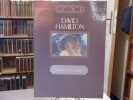
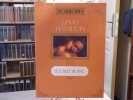
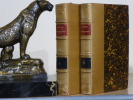
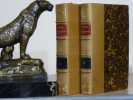

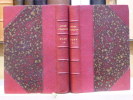





![On Quaternions" or on a new System of Imaginaries in Algebra. - [MAKING THE GENERAL THEORY OF RELATIVITY POSSIBLE]. HAMILTON, WILLIAM ROWAN.](https://static.livre-rare-book.com/pictures/LLX/46875_1_thumb.jpg)
![On Quaternions" or on a new System of Imaginaries in Algebra. - [MAKING THE GENERAL THEORY OF RELATIVITY POSSIBLE]. HAMILTON, WILLIAM ROWAN.](https://static.livre-rare-book.com/pictures/LLX/46875_2_thumb.jpg)
![On Quaternions" or on a new System of Imaginaries in Algebra. - [MAKING THE GENERAL THEORY OF RELATIVITY POSSIBLE]. HAMILTON, WILLIAM ROWAN.](https://static.livre-rare-book.com/pictures/LLX/46875_3_thumb.jpg)



